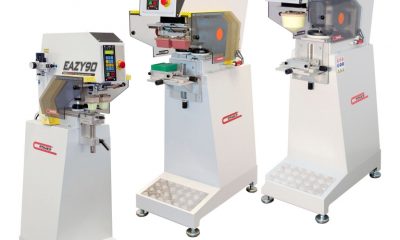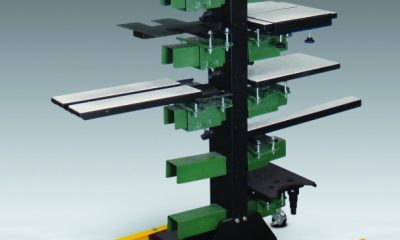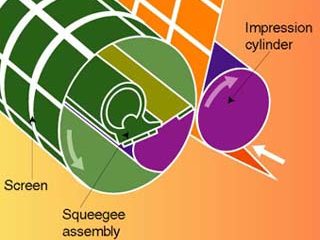Pad Printing
Published
22 years agoon
As with any process-color printing, registering four-color pad-printing jobs is a challenge. Before you can achieve accurate registration, you must fully understand and control all aspects of the pad-printing process. We define printing as replicating original artwork by laying down a controlled thickness of ink. We use the term "replicating" rather than "copying" to emphasize the level of precision you must achieve in order to get a quality print.
As with any process-color printing, registering four-color pad-printing jobs is a challenge. Before you can achieve accurate registration, you must fully understand and control all aspects of the pad-printing process. We define printing as replicating original artwork by laying down a controlled thickness of ink. We use the term "replicating" rather than "copying" to emphasize the level of precision you must achieve in order to get a quality print.
While process-color printing of any type requires precise control, reducing variables in pad-printing is particularly important. The variables you must consider include machine tolerances, color-separation quality, ink characteristics, pad specifications, and the accuracy of cliche etching and positioning.
Machine tolerances Pad printing is a thin-ink-film reproduction process. Dried ink films for a single print are approximately 5 microns (0.0002 in.) thick. Because the pad delivers such a thin ink layer on the substrate, this is an ideal marking technique for process-color printing on objects where high ink buildup tends to be problematic.
With conventional single-color pad printing, the quality of the press is not critical–most machines deliver reasonable print definition. But with process-color work, the accuracy and consistency of the machine is of major importance.
Some presses position the object being printed as it moves from one print position to another. On other models, the object remains stationary while a single pad moves between the part and cliches for each color. In both cases, the way the machine positions the part relative to the cliche and pad determines registration accuracy between colors. So the first step you should take to ensure good registration is to purchase a dependable, well-engineered pad-printing press.
Film generation Now that you know it’s possible to accurately register process-color pad prints, you need to look carefully at the color-separating procedures you employ. Specifically, you must consider three items when making separations for digital output: the halftone line count (measured in lines/in.), dot shape, and tonal range represented by the film positive.
The line count of a separation is the line ruling you want to print. With pad printing, this can be up to 200 lines/in. However, we recommend that you work at a lower count of 150 lines/in., which also provides a high resolution image but requires less stringent control of process variables.
When selecting a dot shape, use elliptical dots, which tend to produce crisper details than round dots. We have also experimented with stochastic or random dots, and the results have been fairly satisfactory. Registration accuracy is not quite so critical when using a stochastic dot pattern, but poor registration can give the print a sandy look.
The film-output device you use should produce positives with a 5-95% tonal range. However, because no trim area exists on the printed part, it’s impossible to print targets, gray scales, and color bars that are normally used for measuring registration accuracy, dot gain, and tonal range. That’s why it is always a good idea to experiment with your system by creating independent test prints to measure these print characteristics under specific conditions. Once you’ve done this, it may be possible to use the information in prepress to compensate for the changes that occur on press.
Ink Ink conditions can influence your success when pad printing process colors. The first aspect you need to consider is the amount of pigment in the ink. If your ink supplier provides you with standard process-color inks (yellow, cyan, magenta, and black) and can guarantee that the inks have a consistent pigment density, then you can turn your attention to the other main ink variable–the solvent level.
Because pad-printing inks must have a particular solvent content to ensure proper transfer from the pad to the part being printed, it’s critical to keep the solvent level stable. If your press features an open ink trough, you can maintain the ink’s solvent level by adding measured amounts of solvent at regular intervals.
Closed ink cups certainly make it easier to control the solvent level, but over an extended period, you still have to replace or adjust the ink. Since pad presses use relatively small volumes of ink, we recommend replacing the ink daily, both in closed-cup and open-trough systems.
Pad specifications Whenever possible, use identical pad shapes for printing process colors; variations in pad shape may cause image distortion. Make sure the pads are the same hardness, and when you order pads, make sure the manufacturer sends pads that were produced in the same batch.
Controlling variables
To extend the life of your pads, maintain their condition as recommended by the manufacturer. For more information on pad maintenance, see our article, "Understanding the Pad in Pad Printing," Screen Printing, May ’95, page 111.
Cliche position and etching accuracy The cliche is potentially the most problematic variable in the process for newcomers to pad printing. Printers have two options when setting up cliches for image transfer.
The first method is to use a single cliche etched with each of the four separations. Machines that use this approach offer very limited adjustment options, which means the images must be accurately etched and precisely positioned. The other, more preferable, option is to use four separate cliches, each carrying a single color. Presses that use this system offer greater flexibility in making registration adjustments between colors.
When setting up your press, try not to compromise the positional accuracy of your cliche(s). Without targets, achieving accurate registration can be difficult, but you can get around this problem by looking at the printed image and selecting three positions in the design where all the colors are prominent. These points ideally will be straight edges or uniform geometric shapes against which misregistered colors will be most readily apparent.
Also aim for the characteristic rosette shape that you see in all well-registered process-color prints. We can’t count the number of times we’ve heard printers say "the color is right, but it’s not in register." With four-color process this is simply not possible. If it’s out of register, the color will be wrong.
Although the etch depth of the cliche doesn’t influence registration accuracy, it plays a role in the color accuracy of the print. Basically, you can follow one of two approaches when etching: You can etch every cliche to the same depth and adjust color intensity by modifying the ink. Or you can adjust etch depth independently for each color to provide the desired color intensity.
We prefer the first option because ink adjustments are easier to accommodate. However, if you use this approach, you must be very precise in your ink mixing and keep accurate records of any adjustments you make.
Curing multicolor UV prints
Advances in inline screen-printing equipment now enable screen printers to produce large-format, process-color work with UV inks at rapid speeds. The new generation of presses generally meets very rigorous standards of accuracy and control, and printers who use them are profiting from the high image quality they provide on high-volume orders.
However, if you’re thinking about adding a multicolor inline printing system to your operation, you’ll need to consider more than just printing characteristics as you compare models. The UV-curing devices built into these systems can influence the machine’s overall productivity, and should be carefully compared before you make a decision.
An inline press for process-color printing with UV inks has curing stations between each of the first three colors and a final curing station after the last color. The final curing station always consists of a conventional UV-curing unit. This curing system is used to saturate the completed print with UV energy, which helps ensure that all colors are properly cured and the ink film is firmly adhered to the surface. However, after each of the first three print stations, you have two types of UV-curing systems to choose from: flash (or pulse) or scanning systems.
Flash curing devices function similar to a flash bulb on a camera, using pulses of UV energy to cure the print. The UV energy that cures the print can be delivered in either a single, high-intensity pulse or a series of lower intensity pulses.
These systems generate minimal heat and consume less power than conventional UV-curing units. Printers generally can use flash-curing systems with their existing transparent process-color UV inks.
However, flash curing may not provide sufficient UV output to quickly cure spot colors, which have greater pigment density and require a higher level of photoinitiator, or colors printed on dark substrates. Using the flash-curing unit in such situations can slow production and lead to greater electrical costs.
Scanning involves a conventional UV lamp that is moved across the substrate and back again. The power consumption of such units is greater than with flash curing, but they can cure a broader range of inks. This means that with a scanning system, you aren’t limited to using only transparent process-color inks.
We have clients who use both systems, and they are all very pleased with the results. And surely, the manufacturers of both systems will be able to bombard you with all the advantages of their product and the many disadvantages of their competitors’ products. Just recognize that your choice could affect the overall performance and productivity of your inline printing system.
Before you accept a job for your four-color inline press, make sure that the ink color required for the job can be cured by the system you’ve chosen–you’ll lose the benefit of having a high-speed, large-format press if you use inks that aren’t appropriate.

Subscribe

Magazine
Get the most important news
and business ideas from Screenprinting Magazine.
Most Popular
-

 Art, Ad, or Alchemy1 month ago
Art, Ad, or Alchemy1 month agoF&I Printing Is Everywhere!
-

 Case Studies1 month ago
Case Studies1 month agoHigh-Density Inks Help Specialty Printing Take Center Stage
-

 Andy MacDougall1 month ago
Andy MacDougall1 month agoFunctional and Industrial Printing is EVERYWHERE!
-

 Columns2 weeks ago
Columns2 weeks ago8 Marketing Mistakes Not to Make When Promoting Your Screen Printing Services Online
-

 Editor's Note2 weeks ago
Editor's Note2 weeks agoLivin’ the High Life
-

 Thomas Trimingham2 months ago
Thomas Trimingham2 months ago“Magic” Marketing for Screen Printing Shops
-

 Marshall Atkinson2 weeks ago
Marshall Atkinson2 weeks agoHow to Create a Winning Culture in Your Screen-Printing Business
-

 News & Trends1 month ago
News & Trends1 month agoWhat Are ZALPHAS and How Can You Serve Them in Your Print Business?






